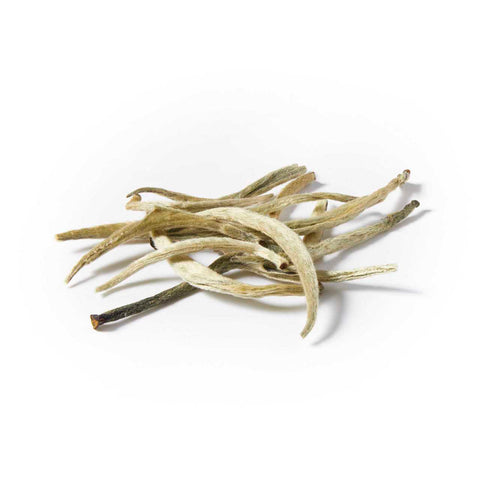What is speciality tea?

Speciality tea is an umbrella term for high quality, often rare, loose-leaf teas and the manufacturing methods might be different to traditional tea making. You won’t find them on the shelves of your local supermarket. Here at Tea Makers of London we specialise in speciality teas predominantly from south and east Asia, from the misty foothills of the Himalayas in India to the coastline of Ise Bay, Japan.
Similarly to wines, you can find cheaper, lower-grade teas right the way up to rare, speciality teas.
High grade or speciality teas tend to use whole tea leaves, buds and flowers, which are hand-picked by experienced workers. Using the whole leaf (rather than grinding it up) makes the flavour much stronger and more complex. These teas usually come from small tea-growing estates; the rarest speciality teas can only be grown in certain areas. Generally, speciality teas are hand-processed and are sometimes aged for years to improve their flavour.
The lowest grade tea leaves are used to make standard supermarket teabags. These leaves are ground up into a fine powder and bagged. Teabags are designed to brewed much quicker than loose leaf teas, as the smaller particles provide greater surface area for the tea to rapidly brew and infuse, but this destroys the flavour in the process.
Is Speciality tea the new fine wine?

Some of the top speciality teas sell at auction for more than £1,000 per kilogram. But apart from these pricy outliers, a speciality tea habit is more affordable than a fine wine collection.
You can get your hands on some of our entry-level specialty teas, such as our Sencha for £4.50 for a 50g pack, which will make around 20 cups of tea. Middle of the range fine teas hit the £10 - £20 mark per 50g, while our seasonal rare teas, such as our Glenburn White Moonshine First Flush Darjeeling, comes in at £26.95 for a 50g pack.
Even the most expensive teas are comparable, if not still more affordable per cup than a glass of fine wine or going out for a coffee.
The beauty of aged tea
Like wine, the flavour of some teas only gets better as they age.
Pu Erh is one of the most popular varieties of aged tea. Fermented using traditional methods, Pu Erh teas are black tea infusions that can be aged for many years. The oldest recorded Pu Erh tea is around 200 years old and would cost thousands to get your hands on. Our Lincang Ripe Pu-Erh is rather fresh-faced in comparison, having been aged for 9 years, but packs in the same complex flavours at a much more reasonable price point.
Maturing tea to deepen its flavour started by accident in China, more than 1000 years ago. Back then, it could take a long time to transport tea to the county’s rural areas. To make it easier to carry and less likely to spoil, teas were compressed into bricks and naturally aged over the course of the journey.
The result? A deliciously complex, fermented flavour that’s still prized today. And as an added bonus, aged teas are packed full of nutrients too. Sipping on a cup of matured tea can take you back in time - you’re literally drinking a piece of history.
Tea is taking over top hotels.
Some of London’s top hotels are recognising the wonder of speciality tea and using it to elevate their afternoon teas, which are increasingly popular. These hotels are making sure the “tea” part is just as special as the cake.
You can visit several luxury hotels to enjoy a menu of high-grade teas and enjoy some of our own products, such as the London Marriott County Hall, The Chesterfield Mayfair Hotel and Oakley Court Hotel. Lots of other hotels are following suit, sourcing only the best teas to serve alongside sandwiches and cakes.
Pairing tea with food
For years, people in the East have drunk tea with main dishes while in the West, we seem to save our brews for breakfast or cakes. But we’re missing a trick here: the right tea infusion can elevate the plate of food it's paired with.
Think about the flavours in your food and try to match them to your tea. For example, strong, meaty flavours will go best with a robust black tea, whereas a delicate dessert will pair wonderfully with a light white tea. Green tea tends to go well with salads, vegetable dishes and sushi, while smoky oolong teas taste brilliant alongside cheese plates.
If you want to find out more about the best teas to pair with your food, check out the ITMA aroma wheel for tea. Designed to mirror the wine aroma wheel, it will help you work out which tea to serve based on aromatics like spicy, sweet, and nutty. But remember, taste is personal, so don't hesitate to try out different combinations.
A healthier indulgence
Who hasn’t woken up with a fuzzy head after one too many wines? Indulging in tea, thankfully, means no hangovers.
Swapping fine wine for fine tea also opens you up to a whole host of health benefits. Tea is full of antioxidants which can help protect your body from damage and boost your immune system, potentially reducing the risk of some diseases. Most teas are good for the gut too, aiding in digestion and soothing stomach pain.
Although you wouldn’t know it from the taste, tea is sugar-free (unless you add it to your cup). This means you can enjoy the luxury of a rich-tasting brew without needing to worry about your waistline. Specialty teas do not require you to add sugar or milk, unlike ordinary teas, which require these to mask the poor quality.
An age-old ritual
There’s something extremely special about the ritual of making and enjoying tea. It’s not hard to see why Eastern culture has valued tea ceremonies for centuries; preparing the perfect cup of tea can bring an unrivalled sense of calm.
With the right tools, tea and teaware, brewing a cup of tea is so much more than simply boiling the kettle and pouring water onto a teabag. The ritual is part of the charm when it comes to speciality tea, using traditional techniques that help you feel connected to tea drinkers of the past.
Which teas to start with?
Black tea- Assam Manjushree

All that glitters is indeed gold when it comes to our single-estate Assam Manjushree. This full-bodied Second Flush tea has a smooth sweetness, comparable to caramel. Harvested in the summer months from the lush hills of the Manjushree Tea Estate in Assam, India, this is perfect way to elevate ones start to the day.
White tea- Ceylon Silver Tips

This single-estate tea is a precious rarity from Sri Lanka. A refreshingly light cup, with delicate notes of pine, pear and honey and a clean floral sweet mouthfeel. Whilst most Ceylon teas are processed as black tea, this rare tea is made from high quality, carefully handpicked unopen buds, and minimally processed to result in a rare, luxurious white tea. Our Ceylon Silver Tips are grown at the Shannon Tea Estate, which has a well-earned reputation for producing spectacular Ceylon tips.
Green tea- Supreme Dragon Well

Warm, roasted nuttiness and refreshing umami grassiness come together in our Supreme Dragon Well. Known in its native homeland as Long Jing, all Dragon Well teas hail from Hangzhou, Zhejiang Province, near the eponymous village of origin. The leaves are pan-fried in a large wok and shaped by hand, a skill that takes workers years to develop. This results in beautiful, flat, feather-like leaves.
Oolong- Oriental Beauty

A premium Taiwanese Oolong, from the mountainous Hsinchu county. This superb tea has a smooth, fruity flavour, with notes of honey and cherry, and produces a beautiful dark orange cup once brewed. The secret of this Oolong is that it is enjoyed by little insects as much as by people. As grasshoppers feast on the tea leaves, this triggers the the plant to to start a proto-oxidisation process and increases the production of polyphenols, which give this tea its smooth, fruity flavour. It is a ‘tippy’ oolong, meaning that only the shoots and containing one bud and two top leaves are chosen to be plucked.
How to brew?
The best speciality teas are best brewed as loose-leaf teas. We offer a range of products designed to make loose-leaf brewing as easy as possible, whilst showcasing the beauty of each individual tea.
We have our ever-popular Easy Glass Teapots. These teapots have a strainer built into the lid, allowing the tea leaves to swirl around mesmerizingly. These teapots have only two main components for ease of cleaning and are dishwasher safe.
For a truly stylish display, our Silver Lining Glass Teapot elevates teatime to a new level of elegance. Matching double-walled glasses are available for a stunning set, fit for higher end speciality teas.
The optimal brewing times and temperatures vary from each tea type. We always recommend following each product’s instructions.
Want even more fine tea options? Why not browse our rare tea selection.




Comments (0)